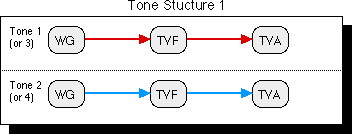
(Copyright 1998, Nathan Sheldon). There is no interaction between the two Tones in structure 1, shown here. Each tone thus acts independently from the other. Structure 1 is the only structure where Tones 1 and 2 (or 3 and 4) do not interact in some way.
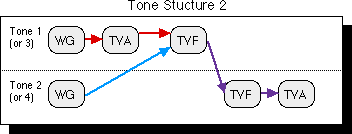
(Copyright 1998, Nathan Sheldon). The primary purpose of structure 2, shown here, is to allow doubling of the cutoff curve of the filter. With only one filter, the cutoff curve is approximately -12 dB per octave. With two filters in series, that can be increased to -24 dB per octave.
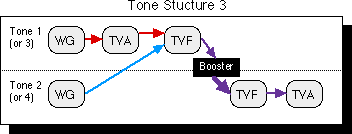
(Copyright 1998, Nathan Sheldon). With the addition of the booster to structure 2, structure 3 (shown here) makes possible such synthesis techniques as PWM (Pulse Width Modulation) by using Tone 1's WG signal to modulate Tone 2's WG signal, then boosting the signal with the booster (so as to clip the peaks of the waveform) and thus creating modulating pulse widths. (See Method of using the Booster to create PWM (Pulse Width Modulation) sound).
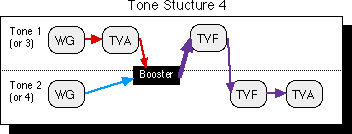
(Copyright 1998, Nathan Sheldon). Structure 4 (above) offers the capabilities of structure 3, but in moving Tone 1's TVF after the booster (instead of before it), the combined filters (Tone 1's and Tone 2's) in series allow for a sharper cutoff curve of the boosted signal to –24 dB per octave.
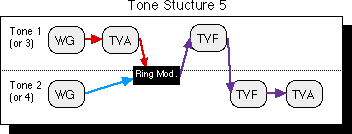
(Copyright 1998, Nathan Sheldon). Structure 5. demonstrated above, is the same as structure 4, but replaces the booster with a ring modulator. The ring modulator offers the ability to create unique, sometimes bell-like sounds with basic (and complex) waveforms. (See Ring Modulator operation).
[go to Tone Structures (6 through 10)]
Back to contents
Graphics version: Main Page || Patches || MIDIs || Specs || Links